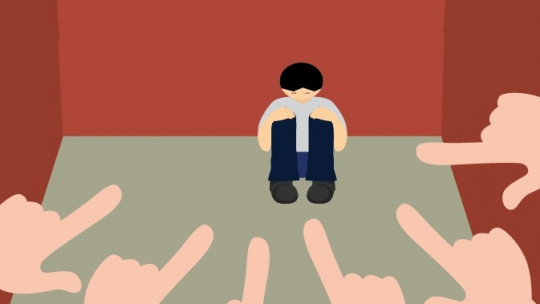Do you feel terrified when going to work? Do you think you may be facing a situation of workplace harassment? Discover how to identify and confront mobbing through psychology to escape unscathed.

Although many do not know him, the workplace bullying or mobbing It is very present today at work. Unfortunately, suffering from workplace harassment can be one of the reasons why a person ends up quitting a job.
What is workplace mobbing?
Mobbing at work could be defined as a type of bullying or harassment at work which ends up harming the mental health of the victim. In many of these cases, bullying ends up causing the person to quit their job and be harmed economically, professionally, and personally.
This type of workplace harassment You may be sued for all the damage you may cause. You should also know that if you find yourself in this situation and you think you can’t tolerate it anymore, you can always request leave due to workplace harassment and even compensation for workplace harassment in the most extreme cases.
Types of workplace harassment
There are many examples of Workplace Harassment to understand how you can detect mobbing at work. Therefore, if you think you are facing one of the situations that will be explained to you below, it is very likely that you are in a case of mobbing or workplace harassment.
- Horizontal mobbing: In these types of mobbing Both the harasser and the victim are in the same hierarchical rank. Therefore, this harassment at work occurs between two colleagues. When this type of workplace harassment occurs, the victims suffer many repercussions on a psychological level, especially in the area of personal self-esteem.
- Vertical mobbing: This abuse at work differs from others because the harasser is at a higher or lower hierarchical level than the victim. That is, you can find two types of workplace harassment What to do in this type. Both ascending, when a higher-ranking employee is attacked by his subordinates; such as downward harassment, which is when a worker at a higher hierarchical level harasses one of his employees.
- Strategic mobbing: He bullying It can go hand in hand with some objectives on the part of the harasser who produces it. So much so that one of the examples of workplace harassment found is when it is part of the company’s own strategy. That is, what they want is to force voluntary dismissal by the worker. This type of workplace harassment is reportable before the law. Furthermore, if there is sufficient evidence, we can obtain compensation for workplace harassment due to all the prejudices that this may have caused us.
- Perverse mobbing: One of these types of mobbing It differs from the others because there is no work objective behind it. The causes of this workplace harassment lie in a harassing and manipulative personality. So much so that the mobbing produced by this type of people goes almost unnoticed by others.
- Disciplinary mobbing: This type of mobbing It is produced to teach a kind of lesson to the person who receives it since they would have to ‘fit into the mold’ because if they don’t they will end up punished. That is, it is basically aimed at those employees who fight against injustices on the part of the company.
These are the types of workplace mobbing that can be found. If you think you identify with any of them, it is vital that you try to remedy these types of situations.

Bullying causes
There are some reasons why bullies resort to these manipulations and attitudes to harm others. So much so that the following causes can be identified for why someone engages in workplace mobbing.
- Personal insecurity: One of the main reasons why the bullying at work It is mainly the insecurity that the attacking person feels. So much so that the majority of profiles that have these attitudes usually suffer from low self-esteem and try to preserve their psychological stability through their hostile behavior towards others.
- Inability to deal with conflict: In many cases of workplace harassment or mobbing, aggressors usually do not have enough tools to deal with conflicts. So much so that they get involved in confrontations just to try to alleviate the pain they feel due to their disabilities.
- Defense mechanisms: Although he Workplace Harassment It usually seems like an offensive weapon, in reality in many cases it is a defense mechanism for the attacker. These are used to avoid facing the reality that the aggressors have in front of them.
- Lack of self confidence: One of the bullying causes It may be due to the lack of confidence that the attacker has in himself. So much so that on many occasions the victim feels inferior in front of the victim and tries to remedy this with his attacks on the victim.
- Inferiority complex: The bully is not able to deal with reality, so much so that he projects this frustration onto the victim. He workplace harassment received is usually due to the inferiority complex that the harasser feels towards the person who receives it.
- Envy: One of the most common reasons for labor abuse It is the envy that the attacker feels. So much so that, in most cases, the aggressor sees the victim as someone better than him. This thinking, along with the aggressor’s inability to cope with frustrations, is the main reason why a person becomes a target.
Consequences of mobbing How to identify workplace harassment?
In order to see if you are really in a mobbing situation at work it is essential to identify each of the signs that victims of workplace harassment encounter.
- Low self-esteem: Constantly suffering from mobbing or harassment at work from peers can cause the person to end up with a self-esteem deficit. So much so that in many cases the victims end up needing the help of a psychologist to overcome this situation of workplace abuse.
- Stress: Although on many occasions the work stress With excessive work, the reality is that burnout can sometimes occur due to work mobbing.
- Lack of trust and security: One of the main consequences of harassment at work It can be a lack of confidence in many aspects of our work. So much so that the person who has received the reprimands may be affected professionally.
- Insomnia: Those who receive any of the types of workplace harassment that have been mentioned, often experience insomnia at night. The causes are mainly due to the bad times experienced during work.
- Depression and anxiety: Finally, if the workplace bullying It lasts for a long time, one of the consequences is suffering from anxiety or depression. This is due to the stress and insecurity that the victim increasingly suffers from.
If you think you are suffering from a situation of workplace harassment, it is essential to consult with a professional psychologist to remedy all its consequences. Both your mental health and your career may be in danger.

How to handle mobbing or workplace harassment?
At first it seems that these situations seem more than unmanageable. Even so, there are some psychological tricks with which you can face the problem. workplace harassment or mobbing by colleagues or bosses.
- Seek moral support: Sometimes it can be a good strategy to seek help or support from other coworkers. On many occasions, when bullies find themselves in a disadvantaged situation, they end up leaving the workplace harassment side.
- Don’t fall into negativity: Although these situations can be very shocking, it is best to try to get ahead with the best thinking. Therefore, it is essential that you do not give up and try to maintain a positive attitude despite the bad environment.
- Let go of what they think of you: Try not to give importance to what others think of you at work. Although it is difficult to leave behind the feelings caused by the bullying it is vital to try to separate the opinions of others.
- Don’t play the role of victim: Accepting that you are the victim will do you no good. On the contrary, on many occasions you will assume this role even though you are not in this role. Therefore, try to take responsibility for your actions to strengthen your position both at work and in general life. On many occasions you may come to face situations of abuse at work through a more confident and secure attitude in ourselves.
- Report it: If you think that the Workplace Harassment A series of mental and personal prejudices are being carried out on you, it is essential that you report it before it has worse consequences for you. To do this, it is vital that you learn how to demonstrate workplace harassment and how you should report it to the law.
- Go to a psychologist: The last step is to go to a mental health professional. On many occasions this situation can overwhelm us, therefore, it is vital to try to rely on a specialist to be able to confront mobbing And carry on.
He harassment at work It is a much more common situation than we can imagine. Despite this, many people do not dare to report these situations. Ending mobbing is vital not only to reach the top of your career, but also to enjoy all aspects of your life.








